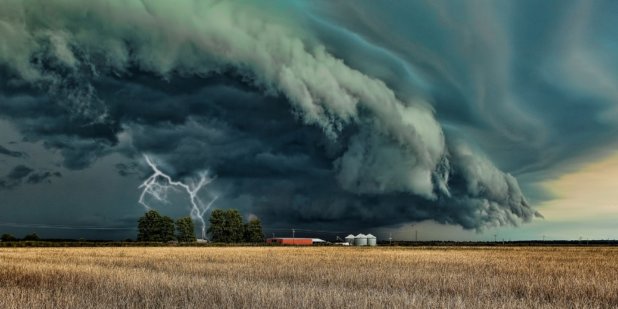- About
- Topics
- Picks
- Audio
- Story
- In-Depth
- Opinion
- News
- Donate
-
Signup for our newsletterOur Editors' Best Picks.Send
Read, Debate: Engage.

While millions of people around the word take part in climate strikes and demand world leaders to take urgent action and end the era of fossil fuels, the Intergovernmental Panel on Climate Change (IPCC) published their Special Report on the Ocean and Cryptosphere, stressing the irreversible changes on a timescale relevant to human societies.
“We will only be able to keep global warming to well below 2°C above pre-industrial levels if we effect unprecedented transitions in all aspects of society, including energy, land and ecosystems, urban and infrastructure as well as industry", states Debra Roberts, Co-Chair of IPCC Working Group II.
All people on Earth depend directly or indirectly on the ocean and cryosphere. Snow and glacier melt from high mountains helps to sustain the rivers that deliver water resources to downstream populations. Take the Indus and Ganges river basins, for example: Snow and glacier melt provides enough water to grow food crops to sustain a balanced diet for 38 million people while supporting the livelihoods of 129 million farmers. The ocean and cryosphere regulate global climate and weather; the ocean is the primary source of rain and snowfall needed to sustain all life on land.
“The open sea, the Arctic, the Antarctic and the high mountains may seem far away to many people. But we depend on them and are influenced by them directly and indirectly in many ways – for weather and climate, for food and water, for energy, trade, transport, recreation and tourism, for health and wellbeing, for culture and identity.”
Hoesung Lee, Chair of the IPCC
The 195 IPCC member governments approved a document that acts as a global warning: Significant sea level rise from Antarctic ice sheet mass loss, which earlier reports did not expect to manifest this century, are already being observed. Human activities are estimated to have caused approximately 1.0°C of global warming above pre-industrial levels.
Ocean warming, acidification and deoxygenation, ice sheet and glacier mass loss, and permafrost degradation are expected to be irreversible on timescales relevant to human societies and ecosystems, even after atmospheric greenhouse gas concentrations stabilise and global warming is kept well below 2°C.
The scale of these changes will challenge the ability of communities, cultures and nations to adapt and respond effectively within existing governance frameworks. Economic and institutional transformations as well as international cooperation including the empowerment of local communities are needed for climate-resilient development.
Sea level has risen globally by around 15 cm during the 20th century and is currently rising more than twice as fast - 3.6 mm per year - and accelerating, the report showed. That is, even with archving the temperature goal set out in the Paris Agreement. Some island nations are likely to become uninhabitable.
Marine heatwaves have doubled in frequency since 1982 and are increasing in intensity. They would occur 50 times more often if emissions continue to increase strongly. The same goes for coastal hazards. The expected annual flood damage will increase by two to three orders of magnitude by 2100. Coastal protection is effective and can be cost efficient for urban and densely populated regions, but unaffordable for rural and poorer areas.
To date, the ocean has taken up more than 90% of the excess heat in the climate system. Almost all coral reefs will degrade from their current state, even if global warming remains below 2ᴼC.
Arctic sea ice extent continues to decline in all months of the year; the strongest reductions in September are likely unprecedented in at least 1000 years. Approximately half the observed sea ice loss is attributable to increased atmospheric greenhouse gas concentrations. Changes in Arctic sea ice have potential to influence midlatitude weather on timescales of weeks to months.
The altered ecosystem threatens key cultural dimensions of lives and livelihoods, including erosion of Indigenous and nonindigenous culture with their knowledge about the ocean as well as water and food security. Ultimately, these can lead to the loss of part of people’s cultural identity and values.
There has been a southward shift in the distribution of Antarctic krill in the South Atlantic, the main area for the krill fishery. These changes are altering biodiversity in polar marine ecosystems and will increase the risk of potential conflicts among fishery area users and authorities.
Snow-cover duration has declined in nearly all regions, especially at lower elevations, on average by 5 days per decade. Smaller glaciers found for example in Europe, eastern Africa, the tropical Andes and Indonesia are projected to lose more than 80% of their current ice mass by 2100 under high emission scenarios. On Arctic land, woody shrubs and trees are projected to expand, covering 24- 52% of the current tundra region by 2050.
The number and extent of wildfires have increased in the Western USA partly due to early snow melt. Most types of natural hazards are projected to change in frequency, magnitude and areas affected. Glacier retreat and permafrost thaw are projected to decrease the stability of mountain slopes, and increase the number and area of glacier lakes.
In some areas as the Western USA, High Mountain Asia and the tropical Andes, where glacier and snow meltwater has decreased, agricultural productivity has declined. Moreover, the release of heavy metals, particularly mercury, and other legacy contaminants currently stored in glaciers and permafrost, is projected to reduce water quality for freshwater biota, household use and irrigation.
The Intergovernmental Panel on Climate Change (IPCC) is the United Nations body for assessing the science related to climate change. More than 100 authors from 36 countries assessed the latest scientific literature related to the ocean and cryosphere in a changing climate for the report that is a key scientific input for world leaders gathering in forthcoming climate and environment negotiations, such as the UN Framework Convention on Climate Change Conference (COP25) in Chile in December of this year.